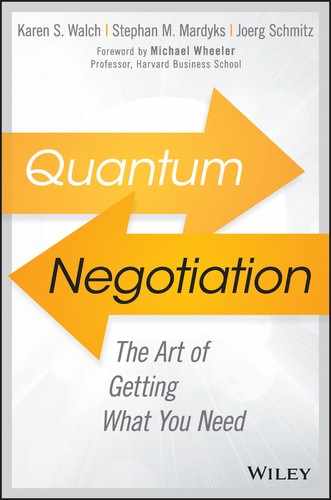Foreword
More than thirty years ago David Lax and James Sebenius coined the term “the negotiator's dilemma” in their classic book, The Manager as Negotiator. It's the so‐called tension between creating value (expanding the proverbial pie) and claiming it (capturing a favorable slice of it).
The tension derives from two opposing impulses. Value creation requires recognition of the parties' respective interests. If they bluff and bluster in order to mask their true priorities, they'll be unable to see how to generate mutual gains by trading creatively on their differing priorities. On the other hand, if one negotiator unilaterally reveals his or her interests while the other does not, the former risks being exploited. The pie may be expanded, but the sly party will get the lion's share.
The creating‐claiming tension (cooperating and competing, if you prefer) isn't merely about outcomes, though. It is more fundamentally about values, identity, and relationships—specifically, self‐regard versus concern for others. Two thousand years ago Hillel posed two questions that are inherent in negotiations today. “If I am not for myself,” Hillel asked, “then who will be for me? But if I am only for myself, what am I?”
Identifying dilemmas, be they substantive or moral, is one thing. Managing them effectively is quite another. Most negotiation books skirt this territory. Yes, some writers address the ethics of specific tactics (such as lying), though typically without exploring foundational principles, attitudes, and beliefs. Now at last, the arrival of Quantum Negotiation warmly invites readers to reflect more deeply about the social nature of a process that is essential in both our professional and our personal lives.
The authors' much‐needed framework builds on and integrates five key insights. First, unlike many writers who take an individualistic approach, their unit of analysis is the interaction between the parties. And so it must be. Negotiation is inherently a social activity. Each party brings his or her attitudes (conscious and otherwise) about what the specific transaction encompasses and, more broadly, what negotiation itself entails. In short, the authors here focus on the dance rather than the steps of a single dancer.
That perspective yields a second insight, namely that negotiation is necessarily a dynamic process. I am not speaking narrowly of the back‐and‐forth exchange of offers and demands. Rather I'm commending the authors' emphasis on how the process itself is always cocreated, especially in regard to the way that relationships emerge. Will the parties be friends or foes, for example? And what are the tacit rules of engagement? Will this be easy or will it be hard? Such questions never can be answered unilaterally. They must be jointly determined. Exactly how things will play out—even between people who know each other well—is seldom fully certain.
The authors take those first two points and add a third, by emphasizing the physical and emotional ways that we experience negotiation. They introduce us to two archetypes who pose questions to the authors throughout the book. First there's Wendy, who relishes negotiation and the thrill of besting her counterparts. And then there's Thomas, for whom the mere thought of the process triggers dread and self‐doubt. It's not the intent of these authors, however, to pigeonhole people or to tell readers to suppress their emotions. Quite the opposite, in fact. Rather, they show how self‐awareness and empathy can be the basis of more satisfying results for all concerned.
They link this third insight to a fourth by reminding us how loaded are some of the terms we commonly use, most notably the word “negotiation” itself. For many people it calls up associations about power, status, vulnerability, and competence.
The word also implies some sort of conditional trading, as in “I'll give you some of this, if you give me some of that.” That framing brings with it an economic outlook, often at the expense of other considerations. To be sure, tangible concerns matter. A candidate for a new job will need to earn enough money to pay her rent, but she'll also want the resources and guidance to perform well. In addition, she'll care about respect and fairness. How we name things shapes our perceptions and drives our behavior. Saying that we are “negotiating pay” takes us down one path. Seeing ourselves as “developing a job description” takes us down another.
Weaving together these first four insights (interaction, dynamics, embodied experience, and a fresh look at framing) the authors build a compelling case for the importance of the mindset that we bring to the process. Here the authors coach Wendy and Thomas to adopt a broader, socio‐centric view of negotiation, one that prompts each to see how his or her particular sense of self is expressed and enacted through dealings with others. The authors also remind us of how, in this day and age, negotiation and leadership are closely intertwined, as each requires openhearted engagement. In addition, the authors provide a practical Quantum Negotiation planning framework.
Most of us know some people like Wendy, as well as others who are closer to Thomas in temperament. In quiet moments, at different times, we may have heard whispers of each of them in our own minds. The question then is whom do we want to summon when we are negotiating for ourselves or leading others? As for myself, I cannot imagine a better companion and guide than a nimble, buoyant, and empathetic Quantum Negotiator.
